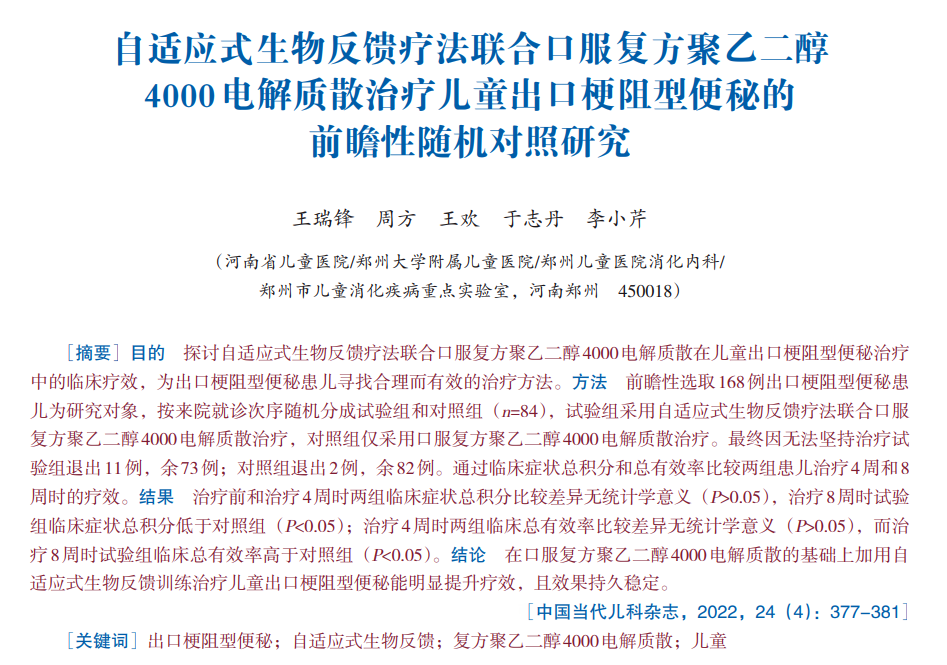目的 探讨自适应式生物反馈疗法联合口服复方聚乙二醇4000电解质散在儿童出口梗阻型便秘治疗中的临床疗效,为出口梗阻型便秘患儿寻找合理而有效的治疗方法。 方法 前瞻性选取168例出口梗阻型便秘患儿为研究对象,按来院就诊次序随机分成试验组和对照组(n=84),试验组采用自适应式生物反馈疗法联合口服复方聚乙二醇4000电解质散治疗,对照组仅采用口服复方聚乙二醇4000电解质散治疗。最终因无法坚持治疗试验组退出11例,余73例;对照组退出2例,余82例。通过临床症状总积分和总有效率比较两组患儿治疗4周和8周时的疗效。 结果 治疗前和治疗4周时两组临床症状总积分比较差异无统计学意义(P>0.05),治疗8周时试验组临床症状总积分低于对照组(P<0.05);治疗4周时两组临床总有效率比较差异无统计学意义(P>0.05),而治疗8周时试验组临床总有效率高于对照组(P<0.05)。 结论 在口服复方聚乙二醇4000电解质散的基础上加用自适应式生物反馈训练治疗儿童出口梗阻型便秘能明显提升疗效,且效果持久稳定。
Abstract
Objective To study the clinical efficacy, advantages, and disadvantages of adaptive biofeedback training combined with oral administration of compound polyethylene glycol 4000-electrolyte powder in the treatment of children with outlet obstruction constipation (OOC). Methods A total of 168 children with OOC were enrolled in this prospective study. All the subjects were randomly divided into a test group and a control group based on the order of visiting time, 84 in each group. The test group was treated with adaptive biofeedback training combined with oral administration of compound polyethylene glycol 4000-electrolyte powder, and the control group was treated with oral administration of compound polyethylene glycol 4000-electrolyte powder alone. Eleven children in the test group and two children in the control group withdrew from the study since they could not finish the whole treatment course. Finally, 73 children in the test group and 82 children in the control group were included in this analysis. As clinical outcomes, the total score of clinical symptoms and overall response rate were compared between the two groups at weeks 4 and 8 of treatment. Results There was no significant difference in the total score of clinical symptoms between the two groups at beginning of treatment and at week 4 (P>0.05), while the test group had a significantly lower total score of clinical symptoms than the control group at week 8 (P<0.05). At week 4, there was no significant difference in overall response rate between the two groups (P>0.05), while the test group had a significantly higher overall response rate than the control group at week 8 (P<0.05). Conclusions Adaptive biofeedback training combined with oral administration of compound polyethylene glycol 4000-electrolyte powder is significantly associated with improvement of clinical outcomes in the treatment of children with OOC.
关键词
出口梗阻型便秘 /
自适应式生物反馈 /
复方聚乙二醇4000电解质散 /
儿童
Key words
Outlet obstruction constipation /
Adaptive biofeedback /
Compound polyethylene glycol 4000-electrolyte powder /
Child
{{custom_sec.title}}
{{custom_sec.title}}
{{custom_sec.content}}
参考文献
1 李英莉, 刘诗. 慢性便秘与肠道菌群[J]. 医学新知杂志, 2019, 29(1): 72-74. DOI: 10.3969/j.issn.1004-5511.2019.01.024.
2 Koppen IJN, Vriesman MH, Saps M, et al. Prevalence of functional defecation disorders in children: a systematic review and meta-analysis[J]. J Pediatr, 2018, 198: 121-130.e6. PMID: 29656863. DOI: 10.1016/j.jpeds.2018.02.029.
3 白铂亮, 曲书强. 儿童功能性便秘的研究现状[J]. 中华实用儿科临床杂志, 2017, 32(7): 554-556. DOI: 10.3760/cma.j.issn.2095-428X.2017.07.021.
4 游洁玉, 赵红梅, 欧阳文献, 等. 儿童功能性便秘肛门直肠动力学分析[J]. 中国当代儿科杂志, 2010, 12(11): 915-917. PMID: 21083991.
5 芦军萍, 黄瑛, 张烨,等.小麦纤维素治疗儿童功能性便秘的疗效观察[J]. 中国当代儿科杂志, 2011, 13(5): 377-380. PMID: 21575341.
6 Rouster AS, Karpinski AC, Silver D, et al. Functional gastrointestinal disorders dominate pediatric gastroenterology outpatient practice[J]. J Pediatr Gastroenterol Nutr, 2016, 62(6): 847-851. PMID: 26513617. DOI: 10.1097/MPG.0000000000001023.
7 贾彦超, 冀春丽, 刘俊杰, 等. 生物反馈治疗出口梗阻型便秘的临床观察[J]. 中国肛肠病杂志, 2018, 38(7): 63-65. DOI: 10.3969/j.issn.1000-1174.2018.07.030.
8 Bharucha AE, Pemberton JH, Locke GR. American Gastroenterological Association technical review on constipation[J]. Gastroenterology, 2013, 144(1): 218-238. PMID: 23261065. PMCID: PMC3531555. DOI: 10.1053/j.gastro.2012.10.028.
9 卜照耘, 张圣军, 孙小兵, 等. 生物反馈治疗小儿功能性出口梗阻型便秘临床评价[J]. 中华小儿外科杂志, 2006, 27(5): 276-277. DOI: 10.3760/cma.j.issn.0253-3006.2006.05.020.
10 Jarzebicka D, Sieczkowska J, Dadalski M, et al. Evaluation of the effectiveness of biofeedback therapy for functional constipation in children[J]. Turk J Gastroenterol, 2016, 27(5): 433-438. PMID: 27782891. DOI: 10.5152/tjg.2016.16140.
11 Palsson OS, Heymen S, Whitehead WE. Biofeedback treatment for functional anorectal disorders: a comprehensive efficacy review[J]. Appl Psychophysiol Biofeedback, 2004, 29(3): 153-174. PMID: 15497616. DOI: 10.1023/B:APBI.0000039055.18609.64.
12 邬怡怡, 史久煜, 李小平, 等. 自适应与固定式生物反馈治疗出口梗阻型便秘的疗效比较[J]. 浙江医学, 2018, 40(12): 1343-1346. DOI: 10.12056/j.issn.1006-2785.2018.40.12.2017-1422.
13 邬怡怡, 史久煜, 李小平, 等. 自适应式生物反馈与复方聚乙二醇电解质散剂治疗出口梗阻型便秘的疗效比较[J]. 现代实用医学, 2018, 30(2): 181-183. DOI: 10.3969/j.issn.1671-0800.2018.02.020.
14 Hyams JS, Di Lorenzo C, Saps M, et al. Childhood functional gastrointestinal disorders: child/adolescent[J]. Gastroenterology, 2016, 150(6): 1456-1468.E2. DOI: 10.1053/j.gastro.2016.02.015.
15 Drossman DA, Hasler WL. Rome IV-functional GI disorders: disorders of gut-brain interaction[J]. Gastroenterology, 2016, 150(6): 1257-1261. PMID: 27147121. DOI: 10.1053/j.gastro.2016.03.035.
16 Lewis SJ, Heaton KW. Stool form scale as a useful guide to intestinal transit time[J]. Scand J Gastroenterol, 1997, 32(9): 920-924. PMID: 9299672. DOI: 10.3109/00365529709011203.
17 Belsey J, Greenfield S, Candy D, et al. Systematic review: impact of constipation on quality of life in adults and children[J]. Aliment Pharmacol Ther, 2010, 31(9): 938-949. PMID: 20180788. DOI: 10.1111/j.1365-2036.2010.04273.x.
18 中华医学会消化病学分会胃肠动力学组, 中华医学会消化病学分会功能性胃肠病协作组.中国慢性便秘专家共识意见(2019, 广州)[J]. 中华消化杂志, 2019, 39(9): 577-598. DOI: 10.3760/cma.j.issn.0254-1432.2019.09.001.
19 Stessman M. Biofeedback: its role in the treatment of chronic constipation[J]. Gastroenterol Nurs, 2003, 26(6): 251-260. PMID: 14676613. DOI: 10.1097/00001610-200311000-00007.
20 张洁, 闫坤龙. 儿童功能性便秘的治疗现状和进展[J]. 国际儿科学杂志, 2019, 46(3): 170-173. DOI: 10.3760/cma.j.issn.1673-4408.2019.03.006.
21 Rao SS. Dyssynergic defecation and biofeedback therapy[J]. Gastroenterol Clin North Am, 2008, 37(3): 569-586. PMID: 18793997. PMCID: PMC2575098. DOI: 10.1016/j.gtc.2008.06.011.
基金
河南省二〇二一年科技发展计划项目(212102310448);2019年河南省医学科技攻关计划联合共建项目(LHGJ20190940)。
 PDF(542 KB)
PDF(542 KB)


 PDF(542 KB)
PDF(542 KB)
 PDF(542 KB)
PDF(542 KB)
